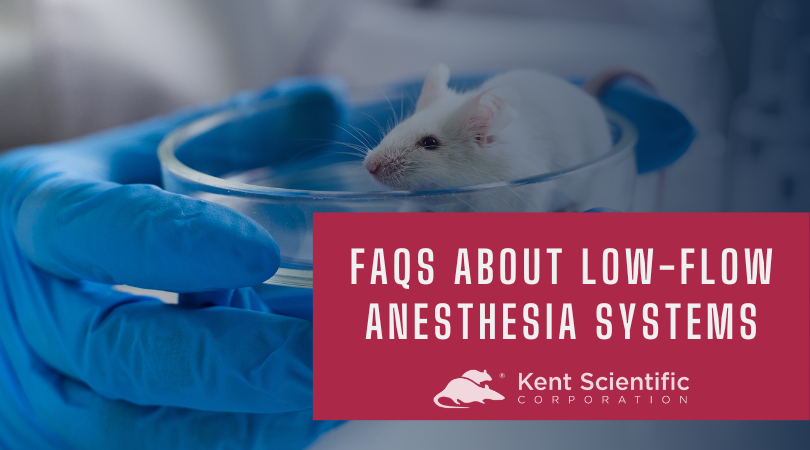FAQs about Low-Flow Anesthesia Systems
Posted on
Rodent anesthesia can be challenging due to the many factors that determine success. For research requiring anesthesia, rodents must be anesthetized accurately based on their size and metabolic rate. They must be monitored to eliminate harmful side effects, and one way to ensure accuracy is to use a low-flow anesthesia system.
There are so many questions worth asking about low-flow anesthesia systems that we decided to compile a list of some of the main ones. Whether you are here as a novice user, an experienced researcher, or simply need to refresh your memory on some of the basics, we have you covered.
What Is a Low-Flow Anesthesia System?
 A low-flow anesthesia system is designed for use on mice, rats and other small animals. These systems deliver anesthesia at much lower flow rates than traditional vaporizers, which benefits both animals and scientific personnel. These low-flow delivery systems accurately administer anesthesia via a precision syringe pump and a digital vaporizer based on the rodent’s size. Delivering liquid anesthetic to an electronic vaporizer via a syringe pump or directly from the bottle, these systems accurately administer anesthesia based on the animal’s weight.
A low-flow anesthesia system is designed for use on mice, rats and other small animals. These systems deliver anesthesia at much lower flow rates than traditional vaporizers, which benefits both animals and scientific personnel. These low-flow delivery systems accurately administer anesthesia via a precision syringe pump and a digital vaporizer based on the rodent’s size. Delivering liquid anesthetic to an electronic vaporizer via a syringe pump or directly from the bottle, these systems accurately administer anesthesia based on the animal’s weight.
Which Anesthetic Agents are Used?
Isoflurane and sevoflurane are commonly used for rodent anesthesia because they are easily administered with a precision vaporizer and result in minimal side effects. Both anesthetic agents have quick on and offset times, allowing a speedy recovery.
How Are the Animals Monitored?
Monitoring animals under anesthesia is crucial for their safety and the validity of research results. In addition to visual observation, a range of physiological monitoring devices are available to track heart rate, body temperature, blood pressure, pulse oximetry, and O2 and CO2 levels. Before testing begins, anesthetic depth is determined by testing the pedal withdrawal reflex, which involves pinching the foot pad on both back feet.
What Side Effects Will the Animals Experience?
When animals are in an anesthetic state, they will be more relaxed, have reduced body temperature, a weaker motor response, and reduced sensitivity to outside stimuli (including pain).
Animals will experience minimal side effects with isoflurane and sevoflurane as they have a quick on and offset period that aids recovery. However, one of the risks of placing animals under anesthesia is they are susceptible to hypothermia and must be closely monitored to ensure their body temperatures are regulated. Keeping animals warm during and after surgery is strongly encouraged as it dramatically reduces the risk of hypothermia and improves recovery. The animal welfare benefits of doing so are self-evident, but researchers can also extend anesthesia periods using warming solutions.
Other short-term side effects could include dry eyes, which can be treated with ointment, and dehydration, which requires warm fluids.
What Additional Components Are Available for Anesthesia Systems?
All anesthesia machines have similar main components, which include a carrier gas source, vaporizer, scavenging system, breathing circuit, and a flowmeter. Some manufacturers offer additional components to support anesthesia applications. These could include additional syringes, vials, and tubing, but other products include temperature monitors, ventilator modules, and pulse oximeters.
What Are the Key Benefits of a Low-Flow Anesthesia System?
There are numerous benefits to using a low-flow anesthesia system. A key advantage is that they offer high levels of precision when administering gases to the animal, which reduces the risk of harm to the animal and lowers the risk of exposure to administering personnel. Other benefits are its cost-effectiveness. Due to the reduced amount of gases used, this prevents waste and helps save money.
Low-Flow Anesthesia Systems at Kent Scientific
Kent Scientific has provided specialist products to medical and research scientists for over 30 years. Our products are designed with the most advanced technology to support preclinical research and drug discovery advancement in laboratories worldwide. One of our products is the SomnoSuite, a low-flow anesthesia delivery system for rats and mice.
Contact one of our team members today for more information on low-flow anesthesia systems and how they could provide you with a safer, more accurate solution.
References:
- UCSF (2020) https://iacuc.ucsf.edu/sites/g/files/tkssra751/f/wysiwyg/Guideline%20-%20Anesthesia%20-%20Rodents.pdf
- Gargiulo, S., (2012) https://pubmed.ncbi.nlm.nih.gov/23382271/